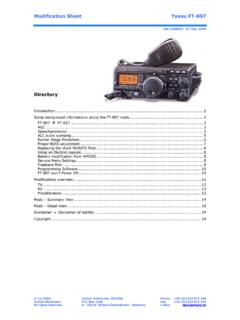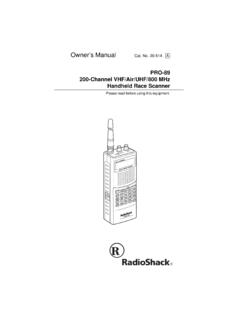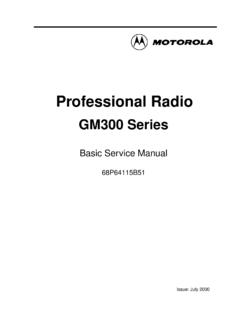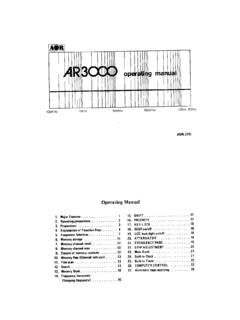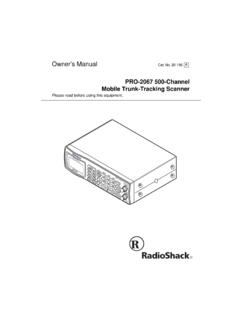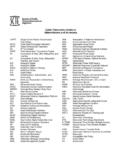Transcription of SERVICE MANUAL - RigPix
1 2003-11 PRINTED IN JAPANB51-8667-00 (N) 694HF / 50 MHz ALL MODE TRANSCEIVERTS-480HX/480 SATSERVICE MANUALDISASSEMBLY FOR REPAIR .. 2 CIRCUIT DESCRIPTION .. 3 COMPONENTS DESCRIPTION .. 14 SEMICONDUCTOR DATA .. 20 PARTS LIST .. 27 EXPLODED VIEW .. 50 PACKING .. 54 ADJUSTMENT .. 55 INTERCONNECTION DIAGRAM .. 76PC BOARD / SCHEMATIC DIAGRAMRF UNIT (X44-327X-XX) .. 78 FINAL UNIT (X45-365X-XX) (A/3) .. 86 FINAL UNIT (X45-365X-XX) (B/3) .. 93 FINAL UNIT (X45-365X-XX) (C/3) .. 96 FINAL UNIT (X45-366X-XX) (A/3) .. 98 FINAL UNIT (X45-366X-XX) (B/3) .. 105 FINAL UNIT (X45-366X-XX) (C/3) .. 108 DISPLAY UNIT (X54-3410-00) (A/3, B/3, C/3).. 110TX-RX UNIT (X57-663X-XX) (A/2, B/2) .. 116 SUB UNIT (X58-4900-XX) .. 128 TERMINAL FUNCTION.
2 129 BLOCK DIAGRAM .. 134 LEVEL DIAGRAM .. 136 ACCESSORIES .. 140 SPECIFICATIONS .. 141 Knob(K29-9270-03)Knob (Main dial)(K21-1105-03)Knob ring(K29-9264-04)Knob(K29-9266-03)Knob(K 29-9267-03)Cabinet (Lower)(A01-2190-02)Knob(K29-9265-03)Kno b(K29-9267-03)Panel assy(A62-1076-03)Key top(K29-9263-02)Stand(J09-0409-03)Microp hone(T91-0638-05)Cabinet (Upper)(A01-2189-02)Panel(A62-1079-01)Fo ot(J02-0441-05) x 4 CONTENTSTS-480HX/480 SAT2 How to remove the torque changeover le-ver (G02-0898-04) the lever section of the torque changeover lever tothe right. (q)2. Insert the tip of a flat-head screwdriver into the recessedpart of the torque changeover lever. (w) the torque changeover lever using the tip of the flat-head screwdriver. (e)Caution: Be careful not to damage the torque changeoverlever when lifting the lever section of the torque changeover lever tothe right, as in the position described in step 3.
3 (r) the torque changeover lever and remove it from thepanel FOR REPAIR qwerHow to mount the torque changeover le-ver (G02-0898-04)1. Insert the torque changeover lever into the mounting loca-tion so that the three tabs align with the torquechangeover slots. ( )2. Turn the lever section of the torque changeover lever tothe left while pressing the surface of the lever as shown inthe Fig. 2, and mount it onto the panel the dry-surf 2400onto the front and rearsurfaces of the torquechangeover 1 Fig. 2 Cautions for mounting the main dial knob(K21-1105-03)Confirm that the lever section of the torque changeoverlever is in the fully turned left position (Torque OFF) beforemounting the main dial for replacing the torque change-over leverApply the dry-surf 2400 onto the front and rear surfacesafter replacing the torque changeover lever.
4 (Do not apply thedry surf to the lever section.)TS-480HX/480 SAT3 Frequency ConfigurationFigure. 1 shows the frequency configuration of this trans-ceiver. All modes operate in a double conversion while trans-mitting. FM mode operates in a triple conversion and othermodes operate in a double conversion while DESCRIPTIONPLLLMX2360 VCO1 VCO2 ~ ~ REFDDS IF3rd IFLO1RX MIXTX MIXTXMIX455kHzFM (Except FM) (FM)CARCARDSPAF OUTMIC INFM MODANTFig. 1 Frequency configurationReference Signal GeneratorThe reference frequency (fstd), which is used to controlthe PLL frequency, oscillates at in a crystal oscilla-tion circuit (X1, Q1). This signal passes through abuffer amplifier (Q4) and is doubled in a multiplier (Q5) to gen-erate a MHz signal.
5 The signal is used as thereference signal for the DDS (IC1) for the PLL reference sig-nal of the first local oscillator (LO1) and the DDS (IC2) for acarrier (CAR).The SO-3 (TCXO unit) is configured as an option in thistransceiver, so that you can replace the crystal oscillation cir-cuit (X1, Q1) with the SO-3. However, you must cut the R103(0 ) and R104 (0 ) jumper wires to stop the operation of thecrystal oscillation circuit (X1, Q1) when using the LO1 (the 1st local oscillator)A frequency between and is outputusing the signal as the reference signal in the DDS(IC1). The output signal passes through a ceramic filter (CF1)and enters into a PLL (IC3). This signal is divided into 1/8 (1/R) in the PLL and becomes the comparison frequency f forthe frequency between and VCOs (Q451, Q452, Q456) of LO1 oscillate and The oscillation output ofthese VCOs enter pin 6 of the PLL (IC3), then divides into 1/Nin the PLL.
6 The comparison frequency f is compared withthe frequency divided into 1/N by a phase comparator in thePLL, then locks the frequency to use it as the output fre-quency of the DDS (IC1), the output frequency ( ) is swept with fDDS STEP [Hz]=10 x R/N when thestep is 10Hz or fDDS STEP [Hz]=1 x R/N when the step is , LO1 covers the frequency range of with 10Hz or 1Hz PLL output generated by the above-mentionedmethod is amplified at Q15 and passes through a band-passfilter with a cutoff switching circuit, an attenuator, and a low-pass filter, and is then sent to the RF unit (X44-327) as LO1. LO2 (the 2nd local oscillator)The (reference frequency) signal passes througha buffer amplifier (Q4) and is doubled in a multiplier (Q5) togenerate a signal.
7 The resistance of the is distributed since it is used as the reference signal foreach DDS (IC1, IC2). The signal is doubled in amultipler (Q8, Q12) to generate a band-pass filter cuts the high harmonic of signal and the signal is sent to the RF unit (X44-327)as CAR (carrier)The used in the local oscillation and detectionis generated by the DDS (IC2). The output signal sent fromthis DDS passes through a buffer amplifier (Q10) and a low-pass filter, and is then sent to each , ~ ~ 2 Reference signal generator, LO1/LO2/CARDDS AD9835 BRU (IC1)HF TX/RXUSBLSBCWCW-RCWNLo1 RXTXRXTXRXTXRXTXRXTXF ilter offset 1+ + +( ) +( ) -( ) -( )00 Filter offset 2+ + ( RIT)-( RIT)-( RIT)-( RIT)-( RIT)-XIT-( XIT)-( XIT)-( XIT)-( XIT)-( XIT)IF Shift+(IF S)--(IF S)-+(IF S)--(IF S)-+(IF S)-CAR correction+(CAR H) +(CAR H)-(CAR L)-(CAR L)+(CAR H)+(CAR H)-(CAR L)-(CAR L)--HF TX/RXCWN-RFSKFSK-RAMFMLo1 RXTXRXTXRXTXRXTXRXTXF ilter offset 100-(SHIFT/2) -(SHIFT/2)-(SHIFT/2)-(SHIFT/2)0000 Filter offset 2----------RIT( RIT)-( RIT)-( RIT)-( RIT)-( RIT)-XIT-( XIT)-( XIT)-( XIT)
8 -( XIT)-( XIT)IF Shift-(IF S)--(IF S)-+(IF S)-----CAR correction----------Filter offset 2 : DATA filter ON, The amount of IF shift when selecting Center 2210Hz ( RIT) : RIT frequency variable amount ( ~+ )( XIT) : XIT frequency variable amount ( ~+ )(PITCH) : CW pitch frequency (400~1000Hz, Initial value 800Hz)(SHIFT) : FSK shift width frequency (170Hz, 200Hz, 425Hz, 850Hz, Initial value:170Hz)(MARK) : FSK mark frequency (H TONE : 2125Hz, L TONE : 1275Hz, Initial value : 2125Hz)Table 1 LO1 frequency shift dataCIRCUIT DESCRIPTIONTS-480HX/480 SAT5 DDS AD9835 BRU (IC2)CARUSBLSBCWCW-RCWNRXTXRXTXRXTXRXTXR XTXF ilter offset 1+ + +( ) +( ) -( ) -( )00 Filter offset 2+ + piitch----+(PIITCH)--(PIITCH)-+(PIITCH)- FSK tone----------IF Shift+(IF S)--(IF S)-+(IF S)--(IF S)-+(IF S)-CAR correction+(CAR H) +(CAR H) -(CAR L)-(CAR L)+(CAR H)+(CAR H)-(CAR L)-(CAR L)--CARCWN-RFSKFSK-RAMFMRXTXRXTXRXTXRXTX RXTXF ilter offset 100-(SHIFT/2) -(SHIFT/2)-(SHIFT/2)-(SHIFT/2)Stop0-455k 0 Filter offset 2----------CW pitch-(PIITCH)---------FSK tone---(MARK)-(MARK)+(MARK+SHIFT)-(MARK) ----IF Shift-(IF S)--(IF S)-+(IF S)-----CAR correction---- ---- - -Filter offset 2.
9 DATA filter ON, The amount of IF shift when selecting Center 2210Hz ( RIT) : RIT frequency variable amount ( ~+ )( XIT) : XIT frequency variable amount ( ~+ )(PITCH) : CW pitch frequency (400~1000Hz, Initial value 800Hz)(SHIFT) : FSK shift width frequency (170Hz, 200Hz, 425Hz, 850Hz, Initial value:170Hz)(MARK) : FSK mark frequency (H TONE : 2125Hz, L TONE : 1275Hz, Initial value : 2125Hz)Table 2 CAR frequency shift dataReceiver CircuitFM mode operates in a triple conversion: the first IF( ), the second IF ( ), and the third IF(455kHz). All modes other than FM mode operate in a doubleconversion: the first IF ( ), and the second IF( ). From antenna to a preamplifier (Q153, 154)There are two antenna terminals: ANT 1 and ANT 2.
10 Withthese antenna terminals, it is possible to select the terminalto be used and store the selection for each band. A pigtailwire is used in this transceiver to maintain the freedom of theantenna wire when it is mounted in a receive signal sent from the antenna terminal entersthe ANT section (X45-366 C/3 : 200W transceiver, X45-365 C/3 : 100W transceiver) of the final unit. The signal passesthrough a surge trap, the antenna changeover relay, the an-tenna tuner changeover relay (only 100W transceiver), thetransmission/reception changeover relay, and an image filter,and is then sent from CN503 to CN2 of the RF unit (X44-327)though a co-axial signal input into the RF unit passes through the at-tenuator circuit, the image filter, the surge absorption limiter,and then enters the RF BPF.
